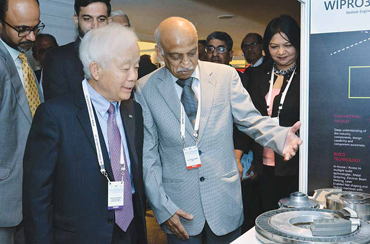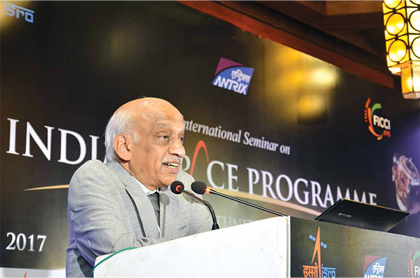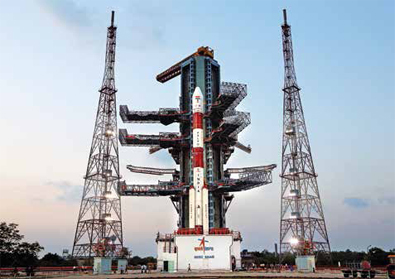The Indian Space Research Organisation is among the few government organisations that have had a series of successes in their missions. The civilian focus of its programmes, together with its use of spartan resources, has helped it achieve path-breaking space strides at lowest cost, recognised globally. Currently it is looking to get the industry engaged at an accelerated pace in its space programmes, and give them a global footprint. Hence, if 2017 proved to be good for space enthusiasts, 2018 can prove to be even better with the many exciting projects in the pipeline from India’s premier space agency.

Thanks to their chalta hai attitude, the general impression about our government departments is that nothing works there. But there is an exception where everything seems to work. So much so that whenever we hear its name, we feel happy because it immediately lifts our spirits. Sometimes it’s for a launch into space from its launch site. Sometimes it’s about PSLV, sometimes GSLV, sometimes a Chandrayan, sometimes a Mars Mission and sometimes about how it launched a whopping 104 satellites, the biggest such launch, in a single mission anywhere in the world!
Any guesses? Yes, you’re right. We’re talking about the Indian Space Research Organisation (ISRO) which functions from Bengaluru as an agency of Government of India’s Department of Space, answerable directly to none else than the Prime Minister himself.
How does it keep breaking new ground, creating new benchmarks and always doing the nation proud?
The man who sits in the hot seat of ISRO, A. S. Kiran Kumar, was recently in the capital to attend a two-day international seminar jointly organised by FICCI, ISRO and ISRO’s commercial arm Antrix, on ‘Indian Space Programme—Trends & Opportunities for Industry’. The modest and completely down-to-earth Chairman of ISRO spoke at length and answered many an uncomfortable question. Exclusive excerpts:
"Today almost 80% of the work related to launch vehicles is being done by them, which allows us to focus on core areas of vehicle engineering, vehicle integration, mission systems and quality assurance. But now we’re going to increase manifold the pace of our activities because we’ve reached a state where more number of launches are going to be done very soon”
For this, we need to give credit to the forefathers of our space programme—Dr Vikram Sarabhai and Prof. Satish Dhawan—who put the entire system and mechanism in place. They made sure that this organisation works with the prime objective of bringing the benefits of space technology for the socioeconomic development of India. They were the architects of a system which focused on advanced space research that led to making the common man of India the principal beneficiary of space applications in various areas like agriculture, weather forecasting, disaster management, communication, navigation, education and health care, to name a few. If ISRO is doing well today, full credit goes to those visionaries.
It has been nice because the way the whole programme started, being the technology of space, much of it was not known. Nobody knew how it’ll operate. So, it gave a kind of freedom to us because the technology was very different and not much of ground intervention was required. All the governments have given us enough freedom to concentrate on our work and deliver. So, to that extent, we’ve had the benefit of keeping at a distance from whatever you’re talking about.

Having realised that space as a technology has tremendous potential and having seen ISRO’s capabilities, they want to know how best we can help them address issues of governance they face on land. That is because in space, our satellites in an orbit are not bound by any state or national boundaries. We can see across things. So, as a result, we can get them a lot of information which is relevant, useful and helps them produce systems which can link the entire country.
We are currently looking at how we can make better communication systems and provide better and effective information for disaster management, planning and monitoring communication services, especially in rural areas, management of natural resources, monitoring of environment and healthcare services, among many others. As technology keeps evolving— whether it is in navigation, location-based services or even mobile applications—we’re trying to bring in all of this to address governance issues. What’s really helping us is the encouraging response of the current government which is very keen to bring in new technologies to provide better services, particularly to rural India.
Well, when we go to somebody and tell him that you can do your job better by following this method rather than how you’ve been doing it, his first reaction is: “Who are you to tell me? I know my job better.” And, that’s natural, but when we keep persisting, they realise, okay, there’s merit in what’s being suggested. Earlier, it used to take us a lot of time to convince people but the current government actually actively supports making use of space technology in very many ways because it’s more aware. So today we’re working with almost 60 central government departments and almost all state governments on various developmental projects including one on crop insurance for farmers.
"The era of just the government working in the space sector is over. Today the global space market is highly competitive, and must be capitalised with industry partnerships and international cooperation”

We’ve been trying to associate our domestic industry in our developmental as well as operational activities from the beginning. In the initial days itself, when we were establishing a space system, they started taking an interest in the Indian Space Programme. At that time we were focusing more on indigenous development of space technology. But we also knew that soon there would be a need to establish the capacity and capability to carry forward the entire gamut of space system activities. We told them that the space business was very risky and the work we were doing wasn’t going to be commercially remunerative to them. For, we didn’t have large number of launches per year and they were few and far between, yet they were ready to take up the work. They took up the task, did the work and did it really well. So, I rate them very highly. But the thing is that the world of space is rapidly changing with technological advancements and disruptive innovations. The key to success is to significantly reduce the cost of access to space in what will prove to be an immense opportunity for the Indian space industry. Though they’re doing good, players in our space industry are significantly short of capacity for our intended goals. ISRO would soon be doubling its launch frequency from about 10 to 20 in a year and therefore they need to really pull themselves up.
We had to work very hard with them and do a lot of quality control, but by its very nature, we knew that we had to work with the industry, make sure that they understood the intricacies of the activity and support them. So, it has been a guru-shishya kind of relationship between ISRO and the industry, and if you talk to any of the industry people who’ve worked with ISRO, you’ll find that they’ve benefitted in capability and delivery. Today almost 80% of the work related to launch vehicles is being done by them, which allows us to focus on core areas of vehicle engineering, vehicle integration, mission systems and quality assurance. But now we’re going to increase manifold the pace of our activities because we’ve reached a state where more number of launches are going to be done very soon. The industry can now actually make use of this opportunity and start profiting by scaling up their involvement in our space programme.

The primary objective of ISRO’s activities is to address specific issues. Today, we have 42 satellites in operation, but what we need for the country is probably more than double this number in terms of its earth observation activities, remote sensing, communication and navigation requirements. This is important if we have to provide effective solutions to the country, its government and monitoring requirements. One of the key requirements for us is to not only increase the number of launches but also make them cost-effective. With this prime objective, we’re trying to engage the industry in a bigger way. Following the success of our complex scientific missions such as Chandrayaan and Mangalyaan, we’ve established ISRO in terms of its credibility. We have built robust partnerships with top international players and therefore the industry has an opportunity to capture even a portion of the global space market which is actually a very significant market. While we ourselves as a government institution will not be looking at this, we want our industry to take this opportunity and move ahead in the larger global space showground.
Being a government body, ISRO has some limitations. We have to work with limited resources and manpower, and therefore we have to rely on our industry and academia to be able to compete with the rest of the world. Please understand that the era of just the government working in the space sector is over. Today the global space market is highly competitive, and must be capitalised with industry partnerships and international cooperation. Over the years, we’ve toiled hard to build our industry by handholding them to a level where they can proudly showcase their strengths, products and services to the world. Now the time has come when they must unleash their instinctive spirits towards acquiring a global footprint.
Dr Vikram Sarabhai, the great visionary, thought of how Sputnik’s new space technology could be brought to the benefit of all countries, when the Americans and Russians were really looking at who was more powerful and mightier in the military domain!”
Today, we have around 500 Indian companies— large, medium and small—from both the public and private sectors, who are contributing actively to space activities in the country. They serve us even with our flagship satellite launch vehicle, the PSLV, but we now want to elevate them from being a vendor to a partner who can be entrusted with assembling, testing and integrating satellites and launch vehicles, either individually or through consortiums. They’re already working on many ISRO projects, but they can also meet the demands of the global supply chain. There is lot of scope for investment in this sector and with the help of Antrix Corporation, our com- mercial arm, and FICCI, we’d like to help build a strong space ecosystem in India for such partnerships and investments.

Many projects are in the pipeline, and there are plans for Chandrayaan-II as well, which is on track. We’re looking to launch it sometime in the first half of 2018, and it’ll mark India’s first landing on the moon. The objective will be to observe the lunar surface and send data to help analyse lunar soil by taking detailed 3-D maps of the moon’s surface. We’re working towards putting an orbiter, lander and the whole system in the lunar orbit in the first quarter of the New Year. The orbiter is getting ready and integrated. The lander and rover are also undergoing various tests. Besides this, discussions are also underway between India and Japan on making use of the space segment to provide inputs on weather monitoring parameters. But that’s not all. A joint lunar mission with Japan is also on the cards, though currently it’s at the initial stage because clear objectives of the mission have not been decided yet. We also plan to carry out a mission to the Sun by 2019, to be named Aditya- 1, and a manned space flight programme two years later. But let’s see how things pan out from here.
Currently, we’re still engrossed with the issue of bringing our capabilities to a certain level. But please remember: ours is a strictly civilian programme. We have not really looked at using space for other kinds of purposes. The resources that have been made available to us for our activities are peanuts, and you cannot compare us with what’s happening in China. If you put together all the money that we’ve spent right from our inception till today, it’ll probably be less than a fraction of what they spend in a year! So, we cannot be compared in that fashion because we restrict ourselves to meet our basic requirements only and don’t have resources for looking at such trajectories. We’re known for being the leader in low-cost satellite launches. We’re now busy with building capacity within the organisation so that we can double the number of launches; we’re also exploring a joint venture entity to build launch vehicles so that we can further cut our costs.
As we keep improving our capabilities, other players in the field also want to come and join us or leverage our global relationship so that the cost of doing things together for the global community also comes down. After our Mars and Chandrayaan missions, even the US space agency NASA wanted to work with us and we’re now doing a NISAR Mission in 2021, though it’s also true that earlier they were not willing to even consider any mission discussions with us. We’ve shown that we’re willing to work with global agencies, be it from Europe, America, Russia or China or the rest, for bringing in solutions that are relevant to global activities and for that we’re also continuously working hard to build our capacity in the required numbers. Keeping the mantra of PM Modi’s ‘Sabka Saath, Sabka Vikas’, in May this year, we launched the South Asian satellite for the benefit of our South Asian neighbours. Earlier in February 2017, we successfully launched 104 satellites belonging to seven countries in the biggest such launch in a single mission anywhere. It created a sort of world record and made us proud. Of the 100-odd nano satellites, as many as 96 were from the United States and one each from Israel, Kazakhstan, the Netherlands, Switzerland and the United Arab Emirates. So, you can see how even world agencies are increasingly showing confidence in our capability.

With over 155 missions including 60 launch vehicles and 90 satellites, we can proudly say that ISRO has now come of age since its inception in 1969 and in the last 48 years of our existence, we’ve toiled to develop and launch satellites for remote sensing, telecommunication, meteorology, navigation and space science and ensured their utilisation for the larger benefit of our people. But going back, in 1957, just about 10 years after independence, when the Soviet Union launched Sputnik and opened up possibilities the rest of the world to conduct a space launch, within six years of that big event, we launched our first sounding rocket from Thumba on November 21, 1963, to carry out some upper atmospheric research. That shows how serious we were about space research, all because of Dr Vikram Sarabhai, the great visionary, who thought of how Sputnik’s new space technology could be brought to the benefit of all countries, when the Americans and Russians were really looking at who was more powerful and mightier in the military domain! He was also aware of what the British science fiction writer Arthur C. Clarke had said that if you put an object into space orbit at about 36,000 kms from the earth, it takes exactly 24 hours to go around the earth and the object remains ‘stationary’. Dr Sarabhai was keen that this technology of space be brought here to link the vast expanse of our country. In 1975, he was the man responsible for coming up with a programme called Satellite Instructional Television Experiment [SITE] where again by virtue of his friendship with American, Russian, French and German scientists, he could borrow from NASA an advanced ATS-6 technology satellite and conducted informational TV programmes for rural India the likes of which had not been done by anyone in the world! It was called the largest socio-technological broadcasting experiment which reached 2004 remote villages of 20 districts of six states [Andhra Pradesh, Bihar, Karnataka, Madhya Pradesh, Orissa and Rajasthan] of our country, using a technology which is very familiar today, Direct To Home, which at that time was called Direct to Community Centre. You can imagine its impact in 1975 when many of our villages had not even an electricity pole, and he used space technology at that time to bring the latest farming and health practices and even entertainment programmes to the doorsteps of our rural farming community! This experiment of one year was enough to convince the government that space technology was the answer to the developmental needs of the country. Today if we’re harnessing space technology for national development, it’s all because of visionaries like Dr Vikram Sarabhai, Prof. Satish Dhawan, Prof. U. R. Rao and such other stalwarts who served ISRO with distinction. After watching how space technology can help them reach and be heard across the country, our politicians also understood its importance and now we don’t need much justification and convincing to make them understand the importance of space technology for achieving national developmental goals.
By Pradeep Mathur